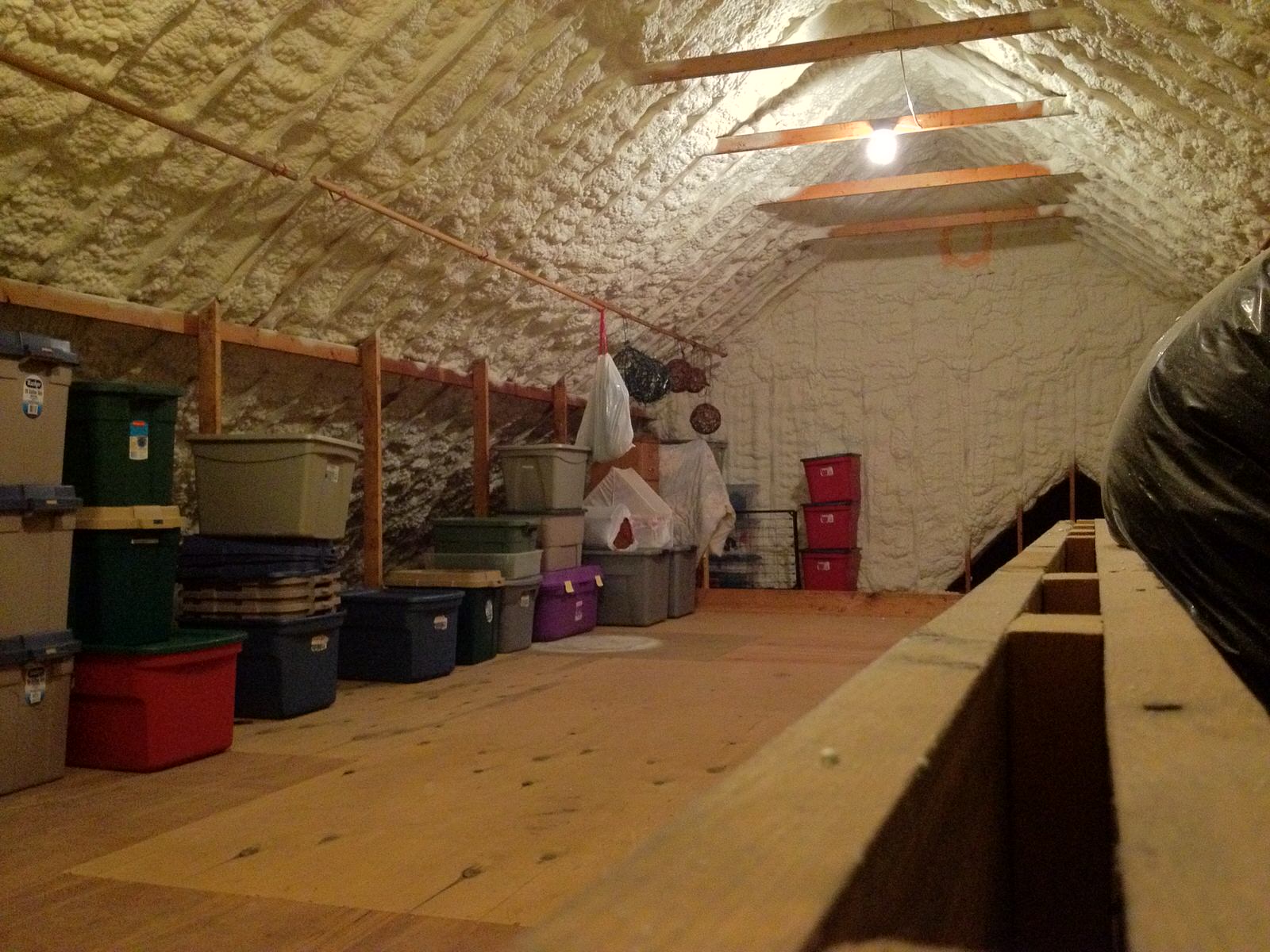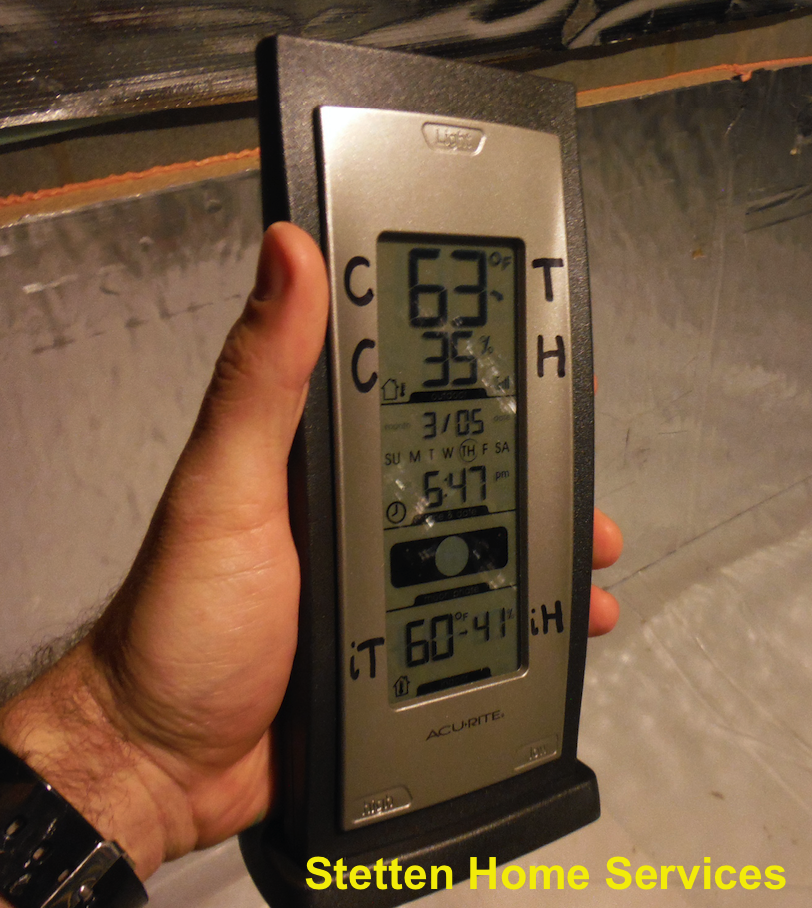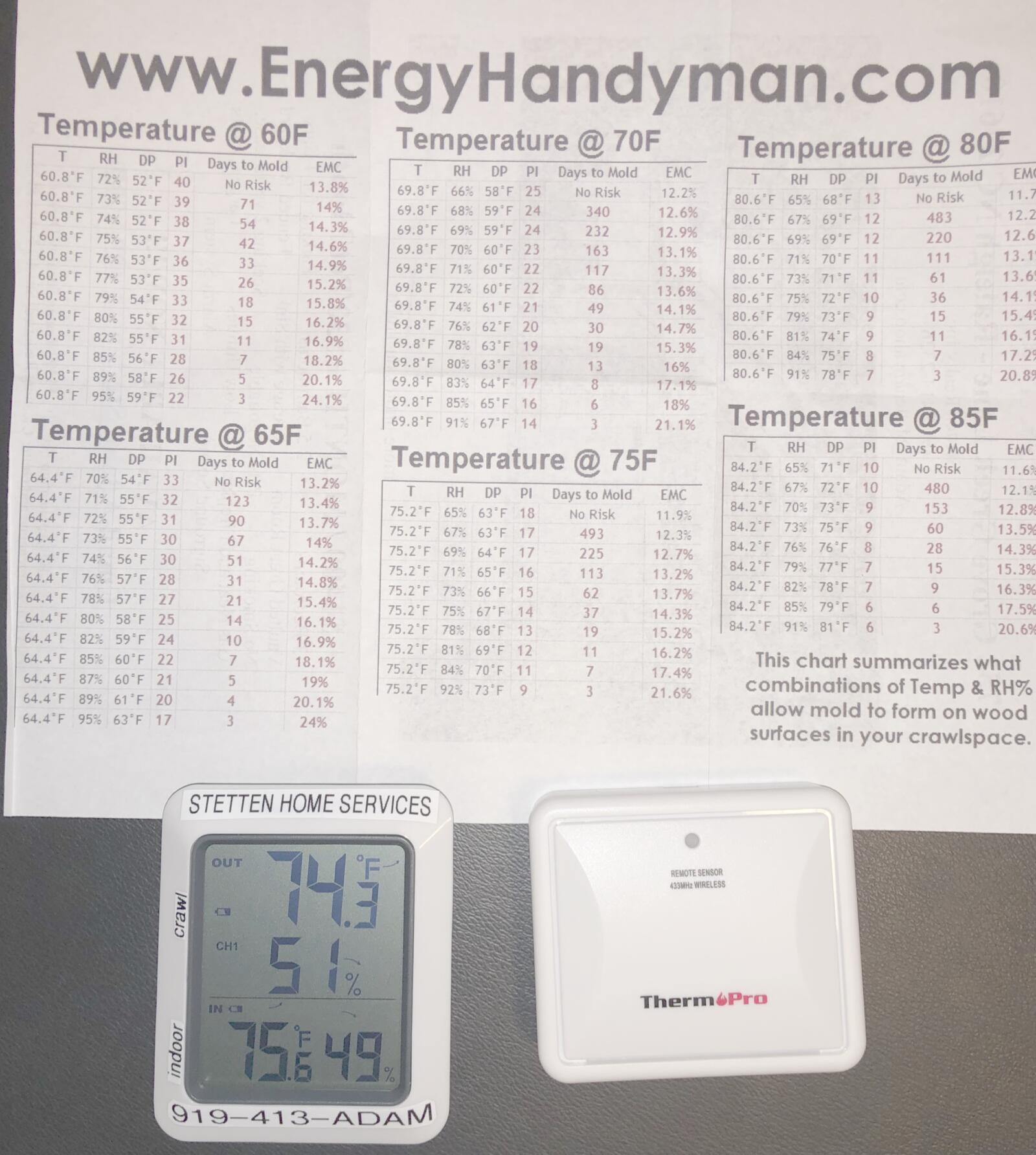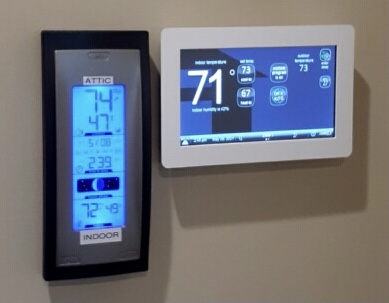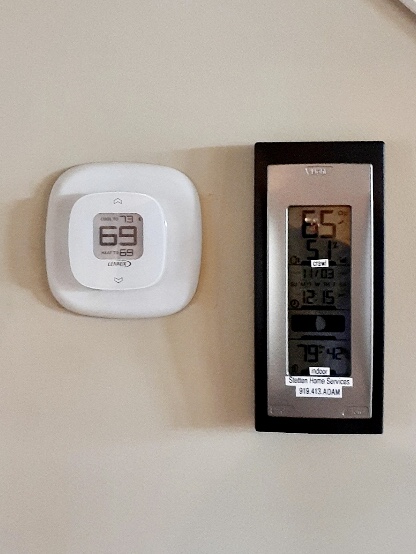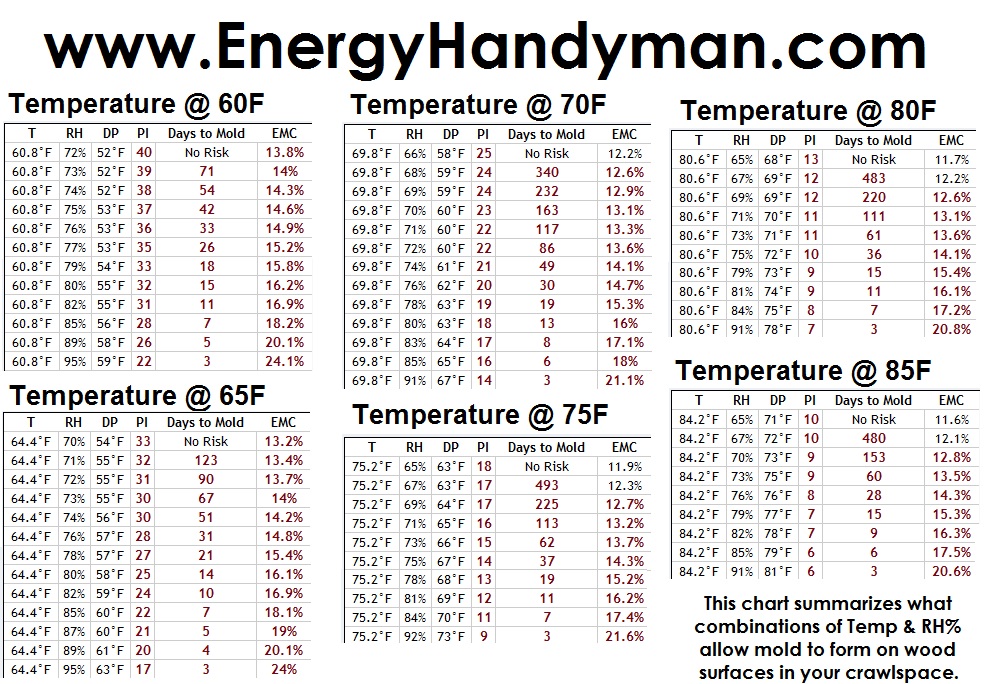Mold Chart for Temperature and Humidity Monitors
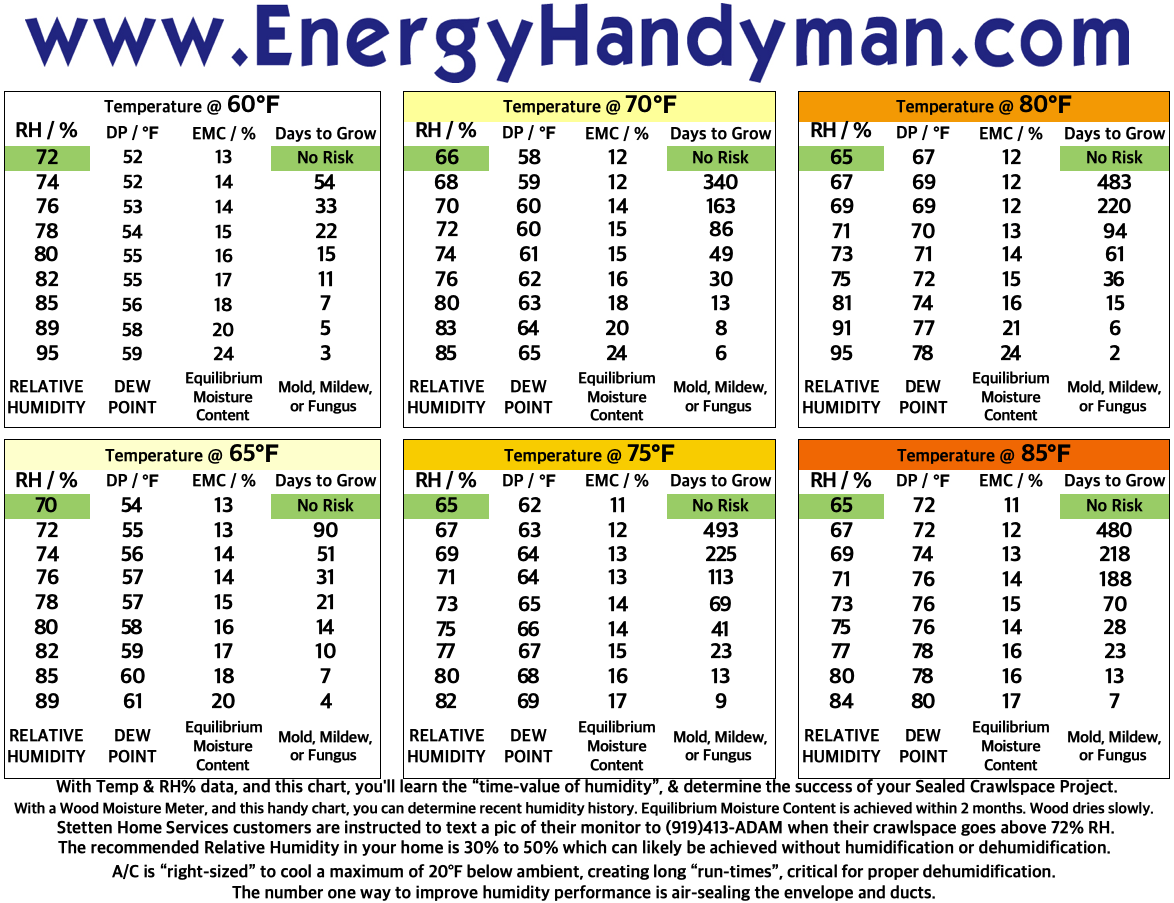
There are often many factors and measures in science where knowing a few allows you to determine others. With Temperature and Relative Humidity you can determine Dew Point of air, Preservation Index of paper, “Days to Mold” of wood, and finally, Equilibrium Moisture Content of wood, respectively. 100% of the above information was laboriously extracted from DPCalc.org which has a good thing going, but people tend to stick between 60F – 80F (with their living conditions) and tolerate rough math at an increasingly delightful rate, and are quite happy with a 1-pager that fully encompasses all the environmental conditions a seasoned building scientist who travels the globe will encounter. Each chart goes from “No-Risk” to “everything you have is garbage in 3 days”. Thank you google for making the Stetten Home Services “Mold-Chart” the number 1 google result on earth.
Generally, in NC or the southeast you want your interior environment dry, as in 50%RH to 55%RH during the cooling season or May – Oct. Indoors, 50%RH or lower is an indication the cooling system is clean, tuned up, and ducts/envelope reasonably air-tight. Crawlspaces don’t have sandwich bread and drywall inside, can and should tolerate higher RH%. The “risk” begins at a low 65% RH at the higher 80F… and at a higher 72% RH at the lower 60F. Risk begins at 65% – 72% RH but there is a long time before mold starts to grow because the wood takes a long time to absorb moisture. After you use the chart for a while, or just look at it long enough you will start to understand the time-value of humidity and how to control topical biological growth. Stetten Home Services tells our clients to text us a picture of their monitor when the humidity eclipses 72% RH in the crawlspace. If a person has a dry home it is easy to inject a trickle of supply air into a carefully sealed crawlspace and keep it dry as well. If a person does not have a dry home, converting a vented crawlspace to a carefully sealed crawlspace results in about 10% drier interior humidity.
1) Hot air can hold more water. Absolute humidity is “relative” to air temperature. At 75 degrees Fahrenheit & 65% RH there is “no risk for mold”. At a cooler 70 degrees Fahrenheit, a more humid 66% RH is still “no risk for mold”. The dynamic relationship between Temperature and Humidity is why it can be confusing and why people need a chart or app for that. A printed chart near your monitor is ideal.
2) Mold, mildew, and fungus thrive better in WET, WARMER, WINDY areas, and on POROUS, ORGANIC objects.
3) Wood takes months to absorb and release water vapors, thus the average conditions in a crawlspace are much more relevant than the highs and lows. Extended Excessive Moisture is an issue that you rarely see in a good sealed crawlspace and see 6-9 months per year in essentially all vented crawlspaces in NC. In Raleigh we consistently see a bump in humidity within sealed crawlspaces during the spring and fall months where temperature is 60-70F and we do not use much heating or cooling. The active drying is absent (if you are using the supply air for the crawlspace drying mechanism) and it is likely humid and raining during those times.
4) Mold and Mildew and Fungus are the 3 topical biologicals and all of them should be treated first, like a moisture problem. Just measure the Temp and RH and solve the moisture problem based on the chart.
5) Air-Samples for “mold” give you say a quantity of spores per 75 liters of air. This information is great to prove there is mold in the air, but by that time anyone who put their eyes or noses on it already knew it wasn’t healthy.
The amount of mold in the air may be inversely linked to the humidity in the air. At any given time that there is “drying period”, like in a crawlspace recently sealed, like every November when folks gets sick, like when the dandelions blow… the conditions are getting dryer, but the topical biologicals are stressed out, trying to get air-born in hopes to spawn elsewhere.
Your initial analysis may say something like 7,000 mold spores per cubic meter of air for a humid vented crawlspace during the middle of the summer, with visible mold and then you may seal it all up, install a dehumidification system, or do waterproofing… and 8 weeks of dryness later after your mold sampler has crawled through the now dusty crawlspace knocking everything down and picking everything up to start your follow up test after the work done, you may have solved the humidity problem, made the space much more inviting and clean, but get an analysis back that there are 77,000 mold spores to the cubic meter.
Once the funk wants to get air-borne it is ripe for vacuuming or “dry-scathing” alone (no chemicals) and you will remove a large majority, maybe 98% of the growth that had a potential to get air-borne. There could still be staining on the wood but the spores are gone.
You could be mistaken to think the mold situation is worse just because the air-born mold was higher. Isn’t that weird? Even this simple inverse connection, air mold vs air-moisture is unknown to many.
5) A properly sealed crawlspace will dry it out in about 6-8 weeks in the summer starting from a pretty wet recent history of conditions. Ideally an old nasty crawlspace would be sealed in February when it is bone dry to start with. Code requires a drying mechanism in sealed crawlspaces and there are several options. The best drying mechanism to have is a small adjustable supply air device, such as a flapper, from an existing air-handler and duct system and for the occupants to understand these lessons, and how to operate their HVAC in a way that promotes drying and and a dry crawlspace. If you let the temperature rise in your home and then you crank down the A/C 10 degrees, it will run for hours, processing lots of air, and get really cold, providing lots of de-humidification for several hours in a row. Some new Thermostats can drive down humidity simply by “increasing the float” from 3 degrees to 4 degrees because the coil gets colder and colder the longer it runs to an extent to which it is pulling gallons of water per hour rather than a few drops at a time. A 2-ton air-conditioner that runs all day pulls 8-10 gallons of water out of the air.
Almost 100% of our clients are steadily in the NO RISK ZONE within 8 weeks of having a Bare-Minimum Sealed Crawlspace Installed.
When you convert from a vented crawlspace with HVAC systems “outside” the heated and cooled envelope to a sealed crawlspace with HVAC systems and everything else in the crawlspace “inside a favorable environment” there is likely a net energy savings for sealing the crawlspace and a direct gain on drying the space out. Often, the energy previously “lost” by the duct work and air-handler is enough so that, once retained, the crawlspace is dry and comfy on average. That is right; you might not need a drying mechanism at all based on excessive leakage. Yet, in this scenario, code requires an intentional mechanical means of drying, so it now makes sense to proactively seal, tune-up, of replace old duct work or equipment with modern ducting and an “ADJUSTABLE DRYING MECHANISM” so you can be deliberate and fine-tune the crawlspace conditions rather than over-drying it by accident. and take the dirty, old, leaky ducts out.
SHS has installed hundreds of these Relative Humidity Monitors in Crawlspaces and Attics across the state each also revealing the temperature and relative humidity of the location of the “indoor base-station”. It gives you 2 data points in 2 locations visible from one location. This Temp/RH information is critical for understanding the actual moisture situations we face. Our chart, which was adapted from DPcalc.org helps immensely to analyze the moisture. The chart has abbreviations that are explained at DPcalc.org.
We recommend installation of a wireless monitor so that we can be sure the conditions in the crawlspace are favorable, and not worse, than the ambient conditions.
— We prefer a unit like this one shown below for many reasons:
– The bezel can be labelled with a Sharpie. These more legible labels: CT, CH, iT, iH can be written on the light grey part to make it easy to see Crawlspace Humidity quickly. You can actually mark-out the word Outdoor on the back-lit display to make it perfectly “not confusing” for your innovative uses. Sharpie is erasable with Sharpie 🙂
– There are no screws for either battery compartment!
– They work great with basic alkaline batteries for up to 2 years. (5) AA batteries. We recommend checking your crawlspace every august at a minimum, and you might as well replace the batteries then.
– Set-Up is easy and relatively automatic as the time and time-zone and DST is automatic.
– The display is back-lit when needed.
– Wall or Table or Shelf mount. Put it right next to your thermostat!
– Affordable.
This “Small” Temperature and Relative Humidity is a new offering. It does not have a back-light, but it is much smaller.
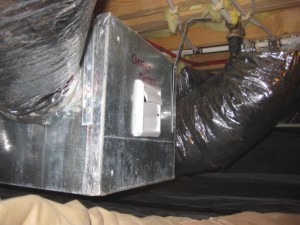
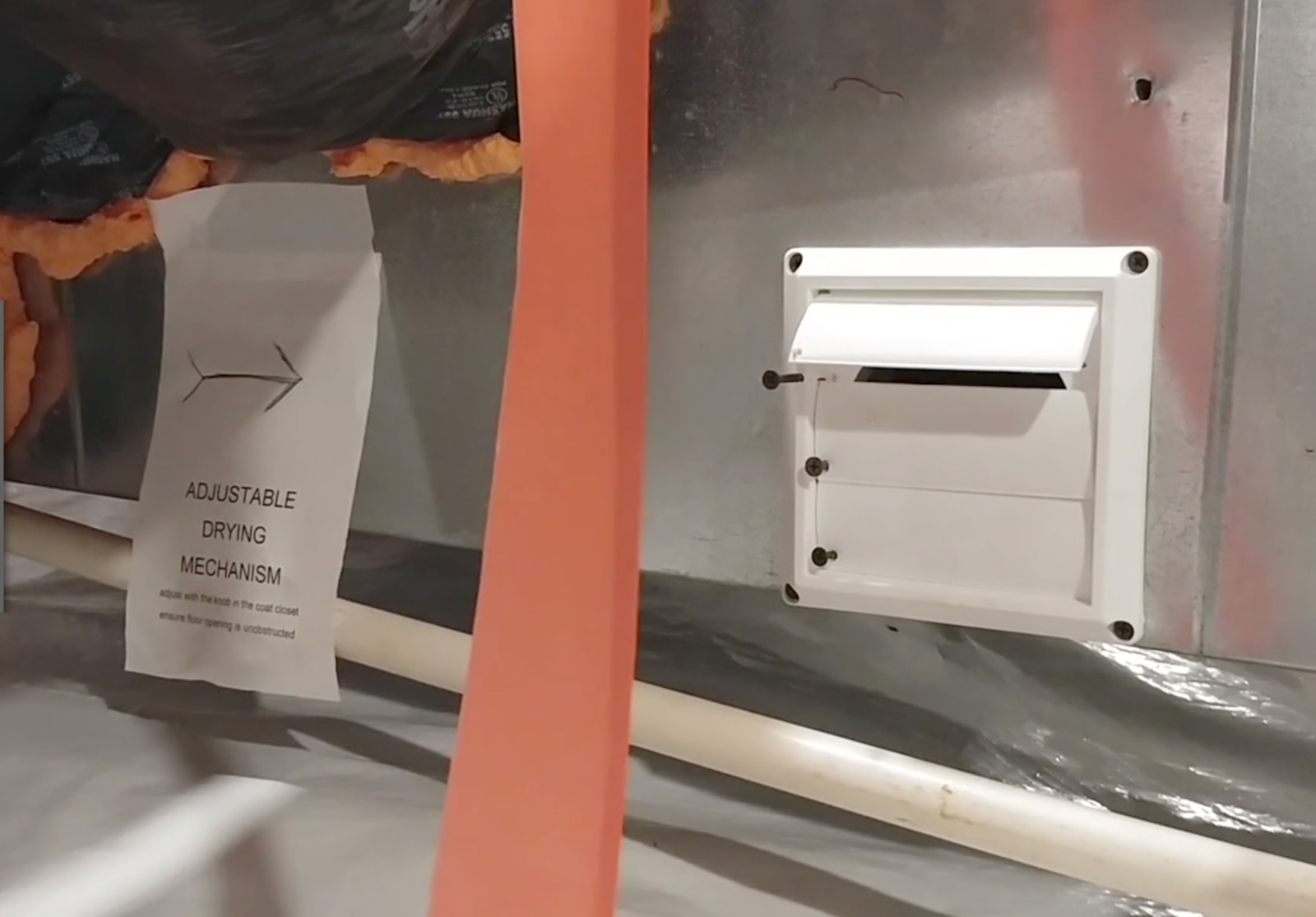
For the people who have the old version printed all over their facility here is the old version:

